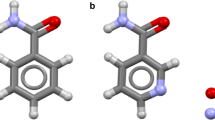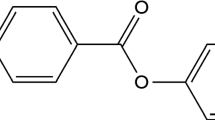Abstract
4-Hydroxybenzaldehyde (4-HOBAL) is an important organic compound widely used in the synthesis of various polymers and pharmaceuticals. It is crystallised in two polymorphic forms, namely Form-I and Form-II. Subtle differences in intermolecular interactions between 4-HOBAL molecules in Form-I and Form-II are analysed to understand the difference in the relative stability of the two polymorphs. Packing energy at room temperature is found to be slightly more stabilising for the stable polymorphic Form-I than for the metastable polymorphic Form-II. It is demonstrated that fine-tuning of the intermolecular interactions by changing the solvent polarity can regulate the outcome of the crystallisation procedure for 4-HOBAL. Crystallites obtained from solvents with a relative polarity of more than 0.654 have Form-I whereas those obtained from solvents with polarity less than 0.654 have Form-II. Colourisation of Form-I crystallites obtained from solutions with water–acid mixtures as solvent is explained based on the presence of hydrated 4-HOBAL molecules within these crystallites. These modified molecules act as local defects that absorb visible photons making the crystallites coloured.









Similar content being viewed by others

References
P Bombicz, T Gruber, C Fischer, E Weber and A Kálmán, CrstEngComm 16, 3646 (2014)
R Purohit and P Venugopalan, Resonance 14, 882 (2009)
S Datta and D J Grant, Nat. Rev. 3, 42 (2004)
Y Wang and Z Liang, J. Crystal Growth 480, 18 (2017)
S Kundu, A Chowdhury, S Nandi, K Bhattacharyya and A Patra, ChemRxiv. Preprint., https://doi.org/10.26434/chemrxiv.13340675.v1 (2020)
E H Lee, Asian J. Pharmac. Sci. 9, 163 (2014)
F Iwasaki, Acta Crystallogr. B 33, 1646 (1977)
J P Jasinski, R J Butcher and B Narayana, Acta Crystallogr. E 64, o187 (2008)
G S Ricardo, E S B Carlos and E M da P Manuel, Cryst. Growth Des. 13, 2803 (2013)
D Sajan, Y Etdogdu, Thomas Kuruvilla and I Hubert Joe, J. Mol. Struct. 983, 12 (2010)
A Gavezzotti, Acc. Chem. Res. 27, 309 (1994)
A Gavezzotti and G Filippini, J. Phys. Chem.98, 4831 (1994)
C F Mackenzie, P R Spackman, D Jayatilaka and M A Spackman, IUCrJ 4, 575 (2017)
CrystalExplorer 3.1 (2013), University of Western Australia, Crawley, Western Australia, 2005–2013, http://hirshfeldsurface.net/CrystalExplorer
R H McKenzie, C Bekker, B Athokpamand and Sai G Ramesh, The J. Chem. Phys. 140, 174508 (2014)
J J Pstewart, J. Mol. Model. 15, 765 (2008)
M F Khan, R B Rashid, M M Rahman, Md Al Faruk, Md M Rahman and M A Rashid, Int. J. Pharm. Pharm. Sci. 9, 217 (2017)
M F Khan, R B Rashid, S M Islam and M A Rashid, SQU J. Sci. 21, 89 (2016)
N L Gilbert and C Melvin, Chem. Rev. 25, 273 (1939)
M F Guest, I J Bush, H J J van Dam, P Sherwood, J M H Thomas, J H van Lenthe, R W A Havenith and J Kendrick, Mol. Phys. 103, 719 (2005)
A Droghetti, I Rungger, C Das Pemmaraju and S Sanvito, Phys. Rev. B 93, 195208 (2016)
Acknowledgements
The authors would like to thank Dr Rekha Rao of Solid State Physics Division, BARC, for recording the Raman spectra of the samples.
Author information
Authors and Affiliations
Rights and permissions
About this article
Cite this article
Choudhury, R.R., Chitra, R., Jayakrishnan, V.B. et al. Effect of fine-tuning of intermolecular interactions on crystallisation outcome: A case study of polymorphs of 4-hydroxybenzaldehyde. Pramana - J Phys 96, 39 (2022). https://doi.org/10.1007/s12043-021-02276-w
Received:
Revised:
Accepted:
Published:
DOI: https://doi.org/10.1007/s12043-021-02276-w



